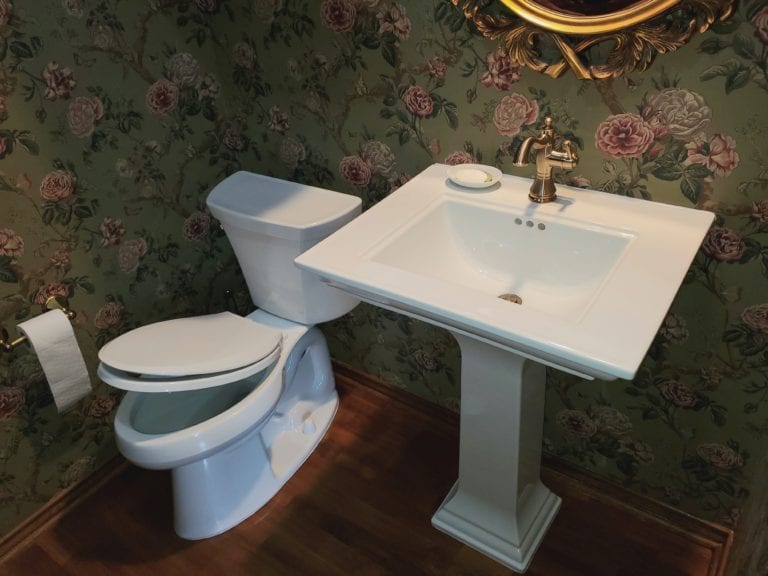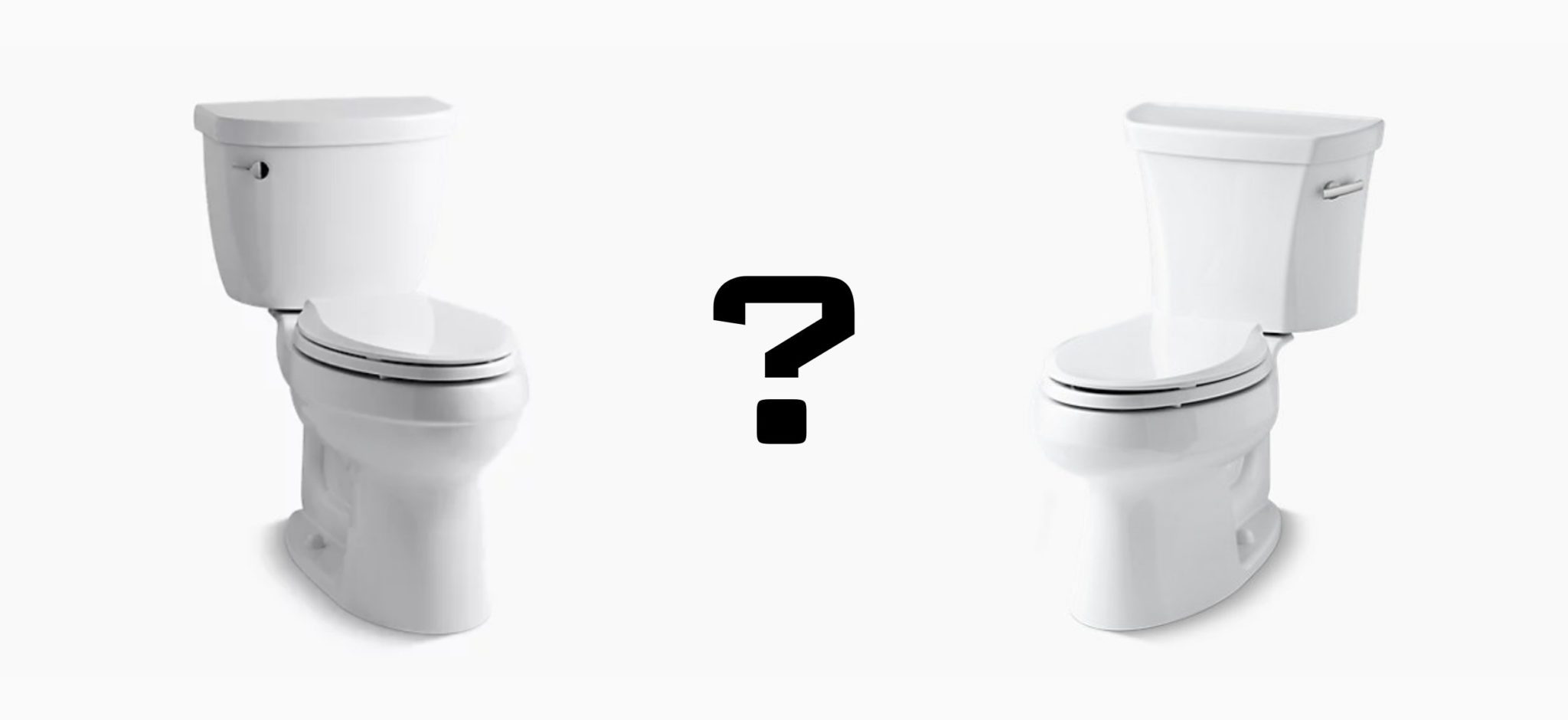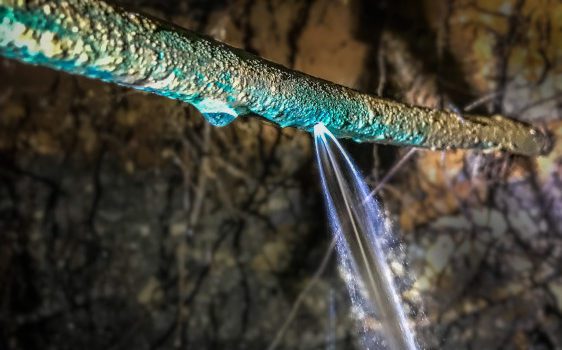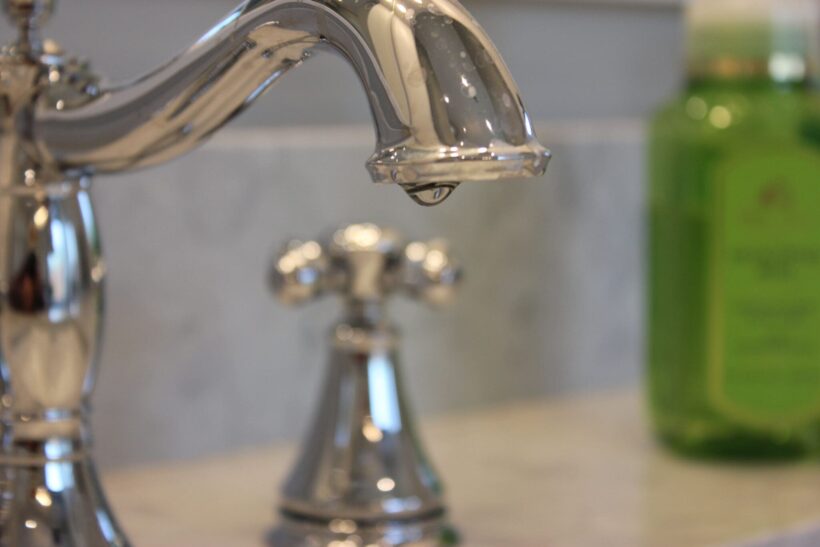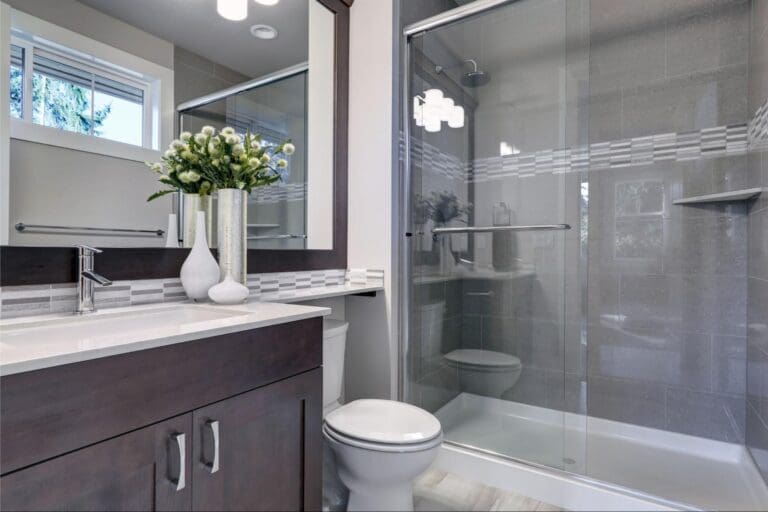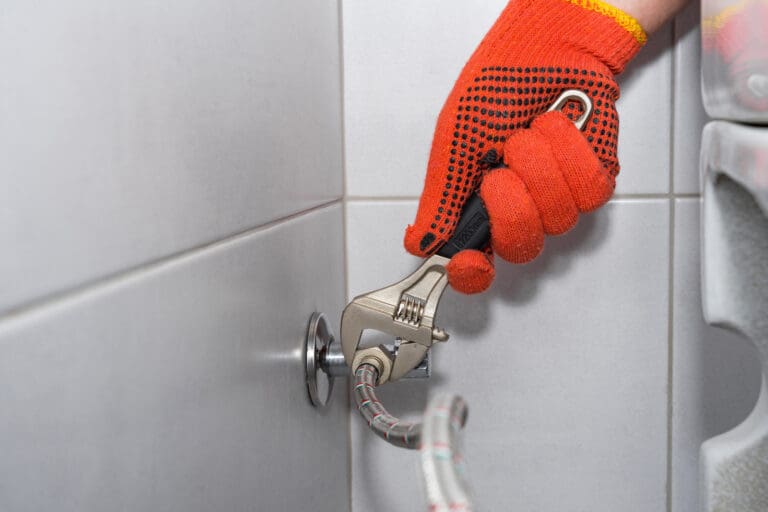When a toilet leaks around the base every time it is flushed, that typically means there is an issue with the flange wax ring seal. The drain pipe for the toilet comes up through the floor and connects to a circular plumbing fitting called a toilet flange that is secured to the floor. This flange is what the toilet mounts to with the toilet bolts (closet bolts).
The gap between the flange and the porcelain outlet of the toilet is traditionally sealed with a wax ring donut-shaped gasket. This keeps all the waste water from leaking as the toilet is flushed. The perimeter of the toilet base is usually sealed to the tile with caulking to prevent dirt from getting up under the toilet where it can’t be cleaned. Unfortunately, when you have a toilet that is leaking around the base, that means the wax ring seal is compromised.
When a toilet is leaking around the base when flushed, this is an issue with the wax ring seal under the toilet. This cannot be fixed by caulking around the base. The toilet has to be removed and reinstalled with a new wax ring.
Furthermore, you can never be sure if the flange itself is still in good condition until the toilet is removed. It is possible that the reason the wax ring seal failed prematurely is because the flange was broken or was installed incorrectly in the beginning. This is a common issue in the Mckinney/Frisco area where we frequently see the flange set too low below the surface of the finished floor. When that is the case, wax is having to seal a much larger gap than it was originally designed to seal. In order to prevent the toilet from leaking again, the best solution is to correct the issue with the flange before reinstalling the toilet.
A toilet that leaks around the base may cause water to appear on the floor around the toilet base, but there is a chance that it is leaking down through the floor and not showing up on top of the flooring. A toilet leaks around the base when the wax ring fails. The wax ring seals the outlet of the toilet to the pipe that comes up through the floor underneath.
If there are signs of water around the base of the toilet, check the shut off valve, supply line, and the place where the tank mounts to the bowl of a two-piece toilet. It isn’t uncommon for there to be a slow leak at one of the bolts that holds the tank on.
If there are no signs of water around the base, a leaking toilet often will rock slightly back and forth on the floor. There may be signs of a buckling wood floor near the toilet or a swollen baseboard. If it is on the second floor, you will likely see a wet spot forming on the ceiling below. Odors around the toilet are also a frequent symptom of a leaking wax ring.
1.28 GPF (Gallons Per Flush). In 2009, the Texas Commision on Environmental Quality adopted a rule that all toilets sold in Texas had to meet certain water saving standards – including a limit of 1.28 gallons per flush rating. Legacy Plumbing’s toilets all meet this requirement. Read more about the toilets we offer on our Toilet Service page.
Many toilet designs that were introduced in the early days of low gpf requirements had a reputation for flushing poorly. Fortunately, advances in toilet design have caught up and most modern water-saving toilets flush as good or better than older toilets did.
If your house was built before 1986 and has a cast iron sewer system, you should NOT replace your toilet with a new one, and you should rebuild the old one if possible. Newer toilets use much less water per flush than older toilets, and this is great for smooth, plastic drain piping – not so much for older cast iron sewer pipes. Because these systems are usually rough and corroded, the large amount of water put down the drain every time an older toilet is flushed helps move all the waste out of the system and prevent more frequent clogs.
If your house was built after 1986 and has a normal PVC sewer piping system, the decision to rebuild or replace really just comes down to an ROI valuation. If the issues with the old toilet will cost more to fix than it is worth to you, it makes more sense to replace it with a new one. If the advantages of a brand-new toilet with a newer, nicer design are not worth the added cost of replacing, it may make more sense to rebuild the old toilet.
Here are some toilet problems that can cause weak flushes:
- If there is an issue with the flush valve or flapper, it may drastically reduce the amount of water that gets put into the bowl with each flush.
- If there is an issue with the fill valve, it can also result in a tank water level that is too low and cause a weak flush.
- Finally, if there is a partial stoppage in the toilet bowl trap or the siphon jet, this will also cause a sluggish flush on a toilet.
If you are having issues with poor flushing performance on a low-flow toilet (1.28 gpm), one of these may be the issue, but it could also be because the toilet was poorly designed in the first place. If the toilet used to flush great, it can probably be restored. If the toilet always has had a weak flush, replacing that toilet may be the best option. There are some really good low-flow toilets on the market (Kohler, Toto, American Standard all make some good models). There are also pressure-assisted flush toilets that can be installed as well if needed.
We have several standard toilets that we carry on our trucks and have ready to go all the time. See our Toilet Service Page for more information on these. If you want a different toilet installed, you will need to provide that and have it at the house when we arrive. It is a good idea to unbox it before setting up the appointment to make sure there are no obviously broken pieces before we arrive.
Probably not. For very weak soft stoppages, dish soap can sometimes help break down the material and make it easier to clear. Due to it’s inefficacy in most situations, we recommend using tools designed for clearing toilet clogs such as plungers or toilet augers.
We provide and install Kohler toilets and have a good experience with those. American Standard toilets and Toto toilets are also popular in this area and are very reliable. If you are purchasing your own toilet, make sure you go with a reputable manufacturer that has good reviews and a good warranty. If you order a toilet online from a manufacturer that is not well established in the industry, you may have little recourse if a problem arises. Remember, a faulty toilet can sometimes result in serious water damage to the home.
No. Although this is sometimes successful at clearing soft stoppages, it is a very bad idea because the rapid change in temperature can easily crack the porcelain toilet bowl. The crack may be something you notice right away, or it may be a hairline internal fracture inside the bowl that leaks and causes water damage.
The best and most effective way to unclog a toilet without removing it is to use a special toilet bowl auger (closet auger). This J-shaped sewer snake is made to fit inside the trap opening of the toilet and clear out any obstructions for 3-6 feet. These can be readily purchased at a home improvement store.
Soft stoppages can sometimes be cleared with the common toilet plunger. This tool is easy to use, but is rarely effective at clearing hard objects caught in the toilet. As toilet bowl designs become more advanced, bowl clogs are less frequent, but the oblong shape of the trap opening has made traditional plungers much less effective. Be sure to purchase one with a rubber flange to help block the siphon jet opening.
In addition to these tools, there are also special power plungers that use stored energy to push through clogs. If none of these methods are effective, the clog is probably further down the system or the toilet will have to be removed.
No, although cat litter will often be able to clear the toilet itself, it has a tendency to collect further down in the drain system and cause clogs. Anything that isn’t organic matter and that a higher density will settle down to the bottom of the pipe. This will be a lot worse on systems that have many changes in direction, a very shallow slope, or systems that have bellies or sags in the line.
Usually not. If the toilet is on the first floor with a slab foundation, then a portion of the slab will either have to be jackhammered to move the drain line or a tunnel will have to be dug up underneath the home. If the toilet is on the second floor, there is often pretty extensive sheetrock removal necessary to expose the drain line for alteration. Sometimes alteration to the framing is required as well. If the toilet is on the first floor over a crawlspace or unfinished basement, this is usually the easiest scenario to work with when remodeling a bathroom and moving fixtures.
Sometimes. Certain models of bidet seats are very DIY friendly. If your toilet has a newer shut off valve in good working condition and you have a level of comfortability with basic plumbing tools and techniques, this may be a doable project. As a decision-making aid, here are some of the things that can go wrong/challenges with bidet seat installation:
- The shut off valve doesn’t not fully shut off to the toilet.
- The shut off valve has a deteriorated rubber washer that breaks into pieces when operated and clogs up the toilet fill valve or new bidet seat when turned back on.
- The shut off valve has a non-standard outlet requiring special adapters.
- The water line tee that comes with the new bidet is cheaply made and cracks when overtightened or develops a leak after installation.
- The water line tee is cross-threaded onto the toilet fill valve thread and damages them requiring a fill valve replacement.
- The water supply lines are not connected/tightened properly and develop a leak after installation.
- The old toilet seat bolts are heavily corroded and require special tools for removal.
- The new bidet seat has a power cord and requires an electrical outlet to be installed near the toilet.
ADA-Height or Comfort-Height toilets are typically around 2” taller than their standard counterparts. The official requirement is 17”-19” to the top of the seat. Elongated toilets are typically around 2-3” longer from the back of the tank to the front of the bowl, but this varies based on the manufacturer. Here is a comparison of the specifications for a few different Kohler toilets:
- The Kohler Wellworth Elongated-Bowl is 14 ½” tall from floor to rim without the seat. It is 30” long from the back of the tank to the front of the bowl.
- The Kohler Wellworth Round-Bowl is 27 ½” long from the back of the tank to the front of the bowl.
- The Kohler Cimarron Elongated-Bowl (ADA Compliant) is 16 ½” tall from floor to rim without the seat. It is 28 ¾” long from the back of the tank to the front of the bowl.
- The Kohler Cimarron Round-Bowl (ADA Compliant) is 26 ⅞” long from the back of the tank to the front of the bowl.
The standard rough-in dimension for a toilet drain pipe is 12” off the back wall. The official requirements in the International Plumbing Code state that a toilet cannot be closer than 15 inches from the centerline to any side wall, partition, cabinet, etc… If toilets are side by side without a wall in between, there cannot be less than 30 inches between the centerlines of the two toilets. Finally, there cannot be less than 21 inches of clearance in front of the toilet to any wall or other obstruction.
A silent toilet leak is a common problem that occurs when the fill valve of a toilet does not shut off completely when the water rises in the tank. It may appear to shut off and go quiet after the tank fills up, but a tiny bit of water is leaking unnoticed into the tank.
The water level inside the tank will slowly rise until it gets to the height of the overflow tube. It stops at that level as the excess water slowly trickles down into the bowl and down the drain.
Unlike a leaking flapper (which will often result in the toilet audibly kicking on from time to time when no one is using it), a fill valve that is malfunctioning in this way has extremely subtle symptoms and can go unnoticed over a longer period of time.
Yes. A rocking toilet almost always results in the wax ring under the toilet being squished and malformed. This may or may not cause the toilet to leak around the base during normal use. Even if the toilet doesn’t leak under normal use, if there ever is a sewer backup, water will begin to dump out around the base of the toilet as the lowest point in the house and flood the bathroom.
Furthermore, a rocking toilet can frequently result in damage to the toilet flange if left uncorrected and result in more expensive repairs down the road. For these reasons, it is always a good idea to fix a rocking toilet as soon as you become aware of it.
Standard toilets are connected to a gravity drain like the rest of the plumbing fixtures in the house. In a situation where a toilet is being added to a space with a concrete slab underneath, the typical and best approach is to either jackhammer the floor or tunnel underneath the home to install a new gravity drain pipe.
If this cannot be done for whatever reason, they sell macerating toilets or upflush toilets as an option. Instead of being connected to a gravity drain, these toilets are connected to a pump that grinds the waste to a sludge and pumps it some distance to wherever it can connect to a traditional gravity drain. While these are used in some situations, they are not common at all in the North DFW area and present their own set of installation and maintenance considerations.
5-7 years is a good rule of thumb, but this varies widely based on the water quality, water pressure, and the quality of the materials used by the different manufacturers. In-tank toilet cleaners or DIY toilet tank chlorine tablets destroy the rubber parts of a tank very quickly. High water pressure can also cause the fill valve to fail much more frequently as well.
Simple Advice for Unclogging Your Toilet
Instead of immediately reaching for the plunger, start by stopping the flow of water. Lift the lid off the tank of your toilet and quick as possible and close the toilet flapper. The flapper releases water from the tank and into the bowl, and by closing it you can stop toilet water from overflowing onto your bathroom. You don’t want to deal with a clogged toilet and a smelly, flooded bathroom.
What is the right plunger, you ask? You need a funnel-cup plunger to effectively create a good seal between it and the toilet bowl. Often people have cup plungers instead, which don’t have the necessary added piece that extends off the bottom of the rubber cup.
Pliant plungers work much better than hard, stiff ones. Run yours under some warm water before using it. We know it’s an extra step, but it’s the difference between a plunger that works the first time and one that doesn’t.
Chances are you’re not an expert on plunging, or you wouldn’t be reading this! Push you plunger into the toilet, until you have formed a seal. Give a few up and down strokes and the flush the toilet. If the water drains, your toilet is unclogged. If it begins to rise, close the flapper again. Repeat the process until you fix the clog.
If your toilet is still clogged, turn to dishwasher detergent and hot water. The combination helps to break up whatever is clogging your pipes. Also, if a plunger isn’t on hand at a friend’s house and you’re too embarrassed to ask, the hot water may be enough to clear the clog without the use of the plunger.
